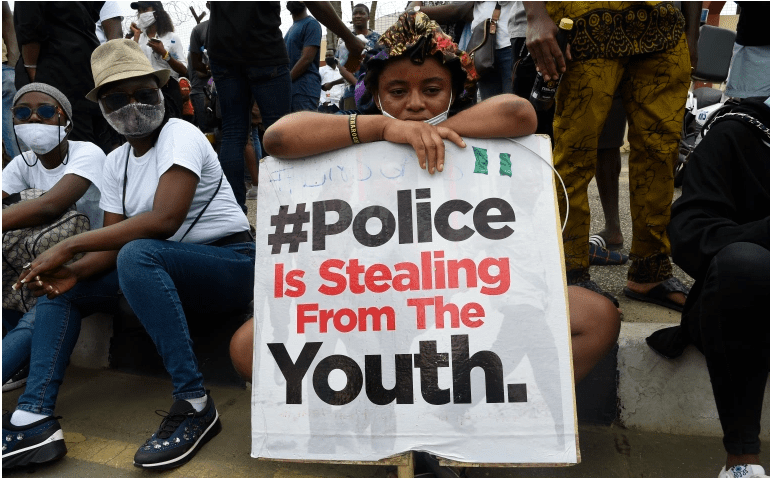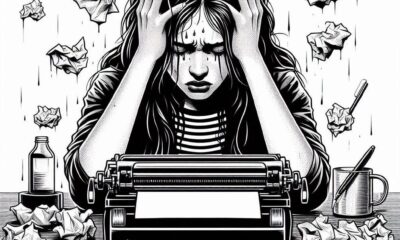National Issues
Every Saturday Evening In Nigeria Before A Mutiny -By Adepoju Isaiah Gbenga
The angry protesters then moved to destroying all the posters and signboards that bore the picture of the governor, and a riot broke out. There were little to watch, but the little was much. A white car which was filled with protesters holding different barbaric weapons soon whooshed in, and tires were burnt at the junctions which was directly linked to Olaiya.

I ask myself if what happened in Osogbo today – OCTOBER 17, 2020 – was a mutiny, a revolution, or a failed coup – due to the attempted murder of the Governor. But critically, it is a mutiny. In the deliberation of the definitions of these terms, they are somewhat similar if not intertwined in their idiosyncrasies.
A mutiny is a coup that is accompanied by a fundamental change in the socio-economic order.
Until today, I believed Osogbo was really peaceful – in fact, the most peaceful in all thirty-six states in Nigeria. But today, when the protest is at its height and has gradually metamorphosed itself into a wide-city riot, chaos broke out.

Saturday morning, rare mornings like first Nigeria coup, was chaotic in Osogbo today, 17th October 2020, and it is a happening I refuse to believe is a peaceful protest. Like the protesters have gone out since three days ago, they came out again, this time early and violent. The first sound I heard instead of the usual honking of big trailers and the overlapping chatter of the hawkers at Olaiya was the sound of cutlasses on the road, the violent honking of bikes and the momentary shout of passersby and hawkers. When I went out, in my red sweater, leaving my hair uncombed and my body unwashed – I rarely bath if at home on Saturdays – and Olaiya had become so crowded that if a pin were to drop, it wouldn’t have touched the ground.
I stood on a pavement, not too far from the center of the action – where big hefty men parade with bikes and foot with cutlasses and whips and woods – one man standing beside said maybe they waited for the governor – Gboyega Oyetola – to come and address them. And even though the other men and women made their other suggestions – like “they are too violent” “Nigeria youths are being wise” “2020 is the most interesting year” and other suggestions and additions – I rather believed the former that they are waiting for the governor.
***
Minutes later, as I had gone in when nobody came, the children that played outside began to shout the arrival of the governor, and that was what pushed me outside at the scene where the governor’s car and convoy was surrounded by the crowd – the protesters – and it didn’t take up to a minute before the crowd began to throw stones and anything solid enough to be thrown at the car and convoy of the governor that was now speeding away, with broken windscreens and broken windows and its side axed.
Rumors were that what the governor had done was unworthy of the post he holds as the governor; some said his responses were disgruntled and displeasing and nonsensical and barbaric and unworthy of note; some even said the last governor – Rauf Adesoji Aregbesola – would have done better; while some believed maybe because the man is too old and unaware (or even negligent) of his immediate environment with the #EndSars protest that has ravaged the whole of the country. Whatever the case might have been, there were mixtures of perception and perspectives, and every passersby that came to me, I agreed on their perceptions and slipped away to avoid more arguments.
The angry protesters then moved to destroying all the posters and signboards that bore the picture of the governor, and a riot broke out. There were little to watch, but the little was much. A white car which was filled with protesters holding different barbaric weapons soon whooshed in, and tires were burnt at the junctions which was directly linked to Olaiya. They might have caused more ruckuses in other streets, but I was unaware – except the smoke I saw curling up in the air from distant junctions. They dispersed – the car and the bikes – through different routes and whooshed in again, to meet at the junction and pass different routes again, all the way causing tremor and fright amidst the citizens who suspiciously watched from everywhere.
The scene was tiring, and for a moment I had concluded that the governor had eloped just to leave the angry protesters wasting themselves away. Little did I know that more chaos and anarchy are still zipping their uniforms and filling their petrol tanks. I was in the house already, half-stripped, preparing to bath when I heard gunshots – at first I dismissed the sound of being a gunshot as I have once had an encounter with a friend who said the sounds are a trick done with bikes. But the sounds were rapid and in quick succession, so I quickly put on my sweater again and tried to go out but I was met with a myriad of people helter-skelter towards me and all shuffling to enter my house – which was a typical fez-me-i-fez-you apartment. I rushed in along with them and locked the door to the veranda, some shouted to open the door but nobody opened it. We were too scared. I was too scared to shout in reply that we were too scared to come open the door. I entered my room and peeped through the half-closed window – a woman and a child hid beside the container outside and they were shriveled like lab specimen.
It was the policemen, we heard, that came with loads of ammunitions and fired everywhere. The group of armed protesters dispersed and they were chased away from the scene. Olaiya, like a graveyard, lulled in silence. The fire of the burnt tires was dying down and leaving only black ashes and cackles. We couldn’t go to the main-road, I climbed a high pavement so as to see the last police Hilux vehicle speeding away.
Till nightfall, it was silence. Total silence. The silence that is only felt in graveyards or in the deep jungle. The sun had rolled away, but there was little phosphorescence of where it stood in the noon, so that dimness separated noon from night – and Odi-Olowo had been crowded with the angry protesters again, this time also holding guns and swords and cutlasses and scythe-like objects. At the junction, which was a direct road from Olaiya, tires were burnt again, this time on the two lanes, in front of the Roykab filling station.
No policemen came; no siren blared; no gunshots were heard; the silence Osogbo felt was ephemeral, too swift to be recorded.
And it was like that till dusk descended – overlapping chatter, the sound of machetes on the road, chants, traders rushing home with their goods and me and my friend, mayowa, arguing randomly about everything. But dusk was lit up by a burning house, the shops beside the post office, that was burnt almost to ashes. The fire burned so high that it seems to be in competition with the thick cloud hovering over it. No fire brigade, I heard, neared the building. Then I heard of the mall being demolished. They stormed into the mall in groups and raided it. The next day, phones were missing and news got out on Social Medias that buying phones from residents in Osogbo (or just out) is dangerous. All these things happened in the shadow of the night – since there was no electricity – so we slept off with a halo of danger hovering over us, knowing that Sunday service would be brief and there would be no market on Monday, only chaos. A riot.
[The governor addressed the citizen and noted in his address that “Osun state #EndSars protesters are not thugs…the protest was hijacked by some political hoodlums…I sympathized with the family that lost their loved ones in the protest”]



















